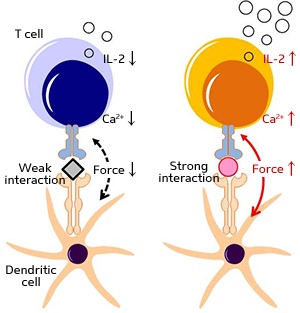
A T cell interacting weakly (left) with a dendritic cell has poor activity. Strong interaction (right) leads to efficient T cell activation, such as a high level of calcium (Ca2+) response and interleukin-2 (IL-2) release.
Using a technique known as single-cell force microscopy, Tong Seng Lim at the A*STAR Singapore Immunology Network and co-workers have measured the mechanical interactions between two cell types crucial for the working of the immune system. The team’s findings might spark new ideas for vaccine development.
T cells of the immune system help protect against pathogens by either attacking them directly or by regulating antibody production by B cells. To initiate appropriate immune responses, they must recognize and discriminate between molecules called antigens, of which there are a vast number of different types. Antigens are presented to T cells by antigen-presenting cells (APCs) by a process that involves direct physical contact and adhesion between the two cell types.
“In recent years, immunologists have learned a huge amount about the molecular components responsible for the physical interaction between APCs and T cells. However, far less is known about how the interaction strength shapes the immune response,” explains Lim. “A particularly interesting but unanswered question is whether the strength of contact itself helps determine the sensitivity and specificity of antigen discrimination by T cells.”
To address this, the researchers used single-cell force spectroscopy—in essence, the use of both atomic force microscopy and optical microscopy—to probe the mechanical interaction between T cells and a particular type of APC called dendritic cells after stimulation using a panel of different individual antigens. They found that the strength of the force depended on precisely which peptide was presented to the T cell by the dendritic cell. Moreover, the stronger the interaction induced by a particular peptide, the more likely it was that the T cell would be fully activated (see image).
“Our findings show that mechanically strong, stable interactions between T cells and dendritic cells are crucial for driving T cell activation,” says Lim.
Further experiments revealed that the strength of binding between the T cell and the dendritic cell did not exclusively depend on surface receptors and adhesion molecules at the contact zone between the cells. Instead, the researchers found that binding strength also depended on the dynamics of the cell skeleton and the integrity of specialized cell membrane regions called lipid rafts.
“I believe we are the first to demonstrate the physiological relevance of physical contacts between dendritic cells and T cells to the functional response of T cells,” says Lim. The researchers hope their findings will contribute to the future development of new and more effective vaccines.
The A*STAR-affiliated researchers contributing to this research are from the Singapore Immunology Network.



